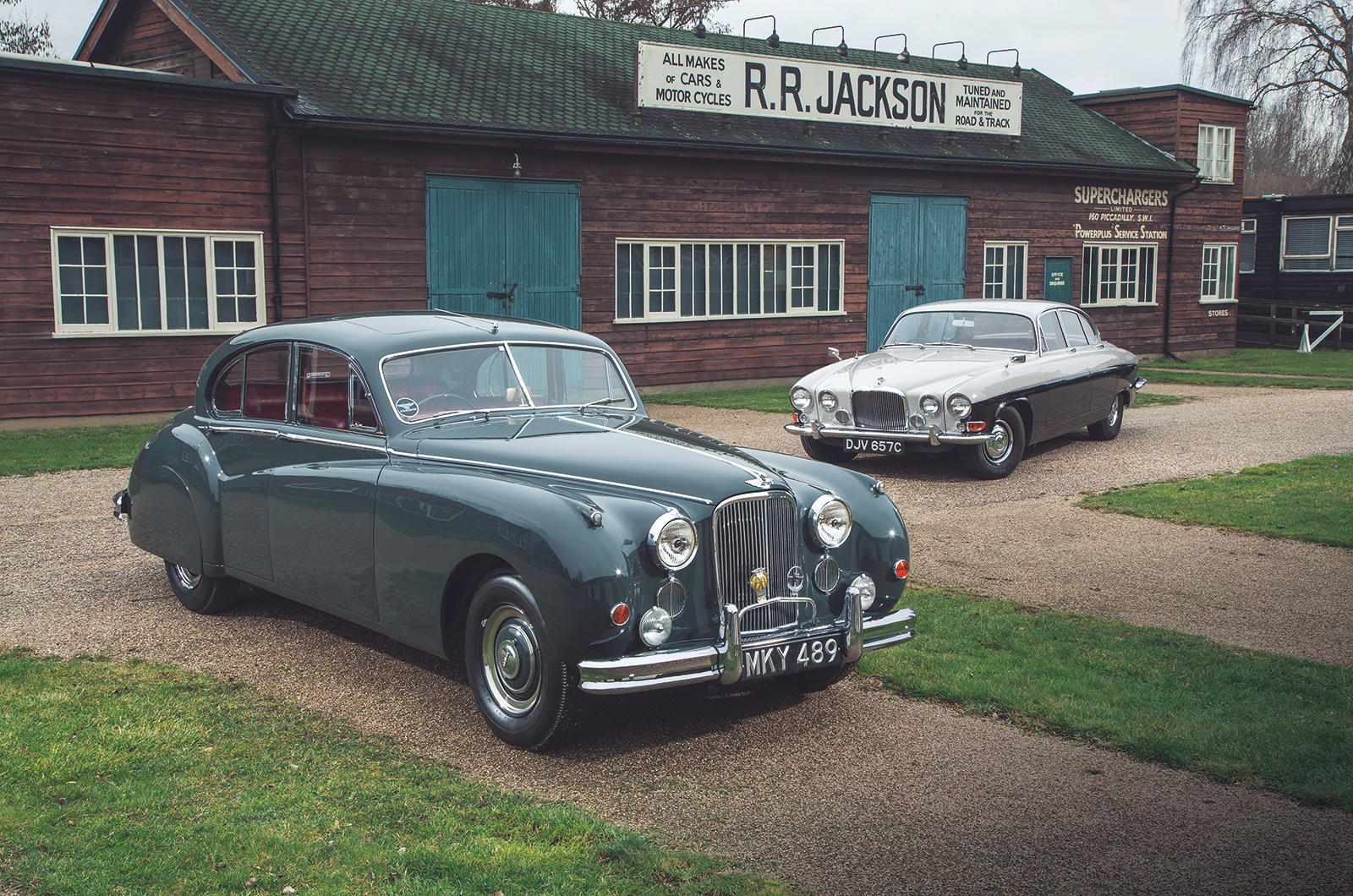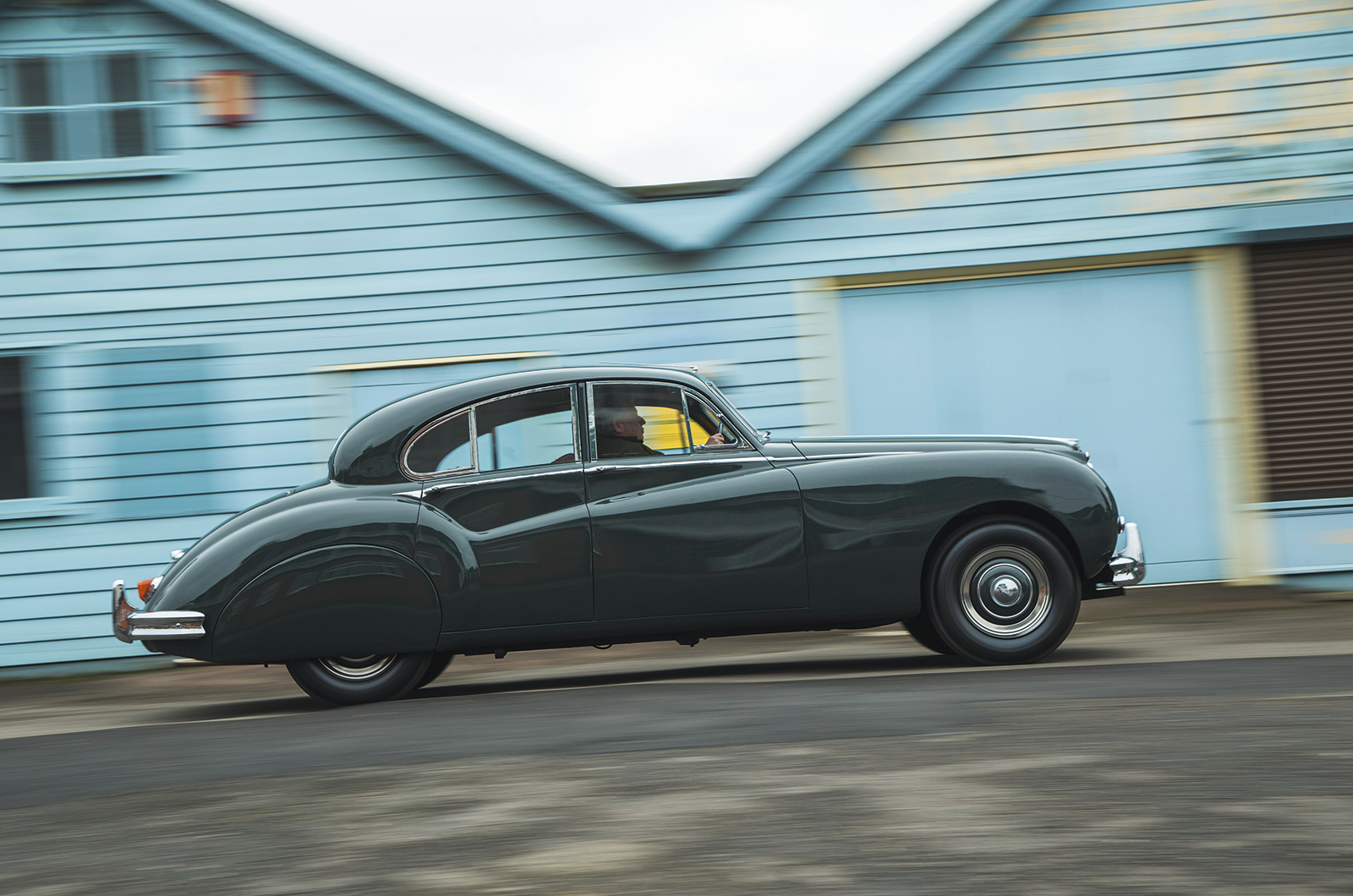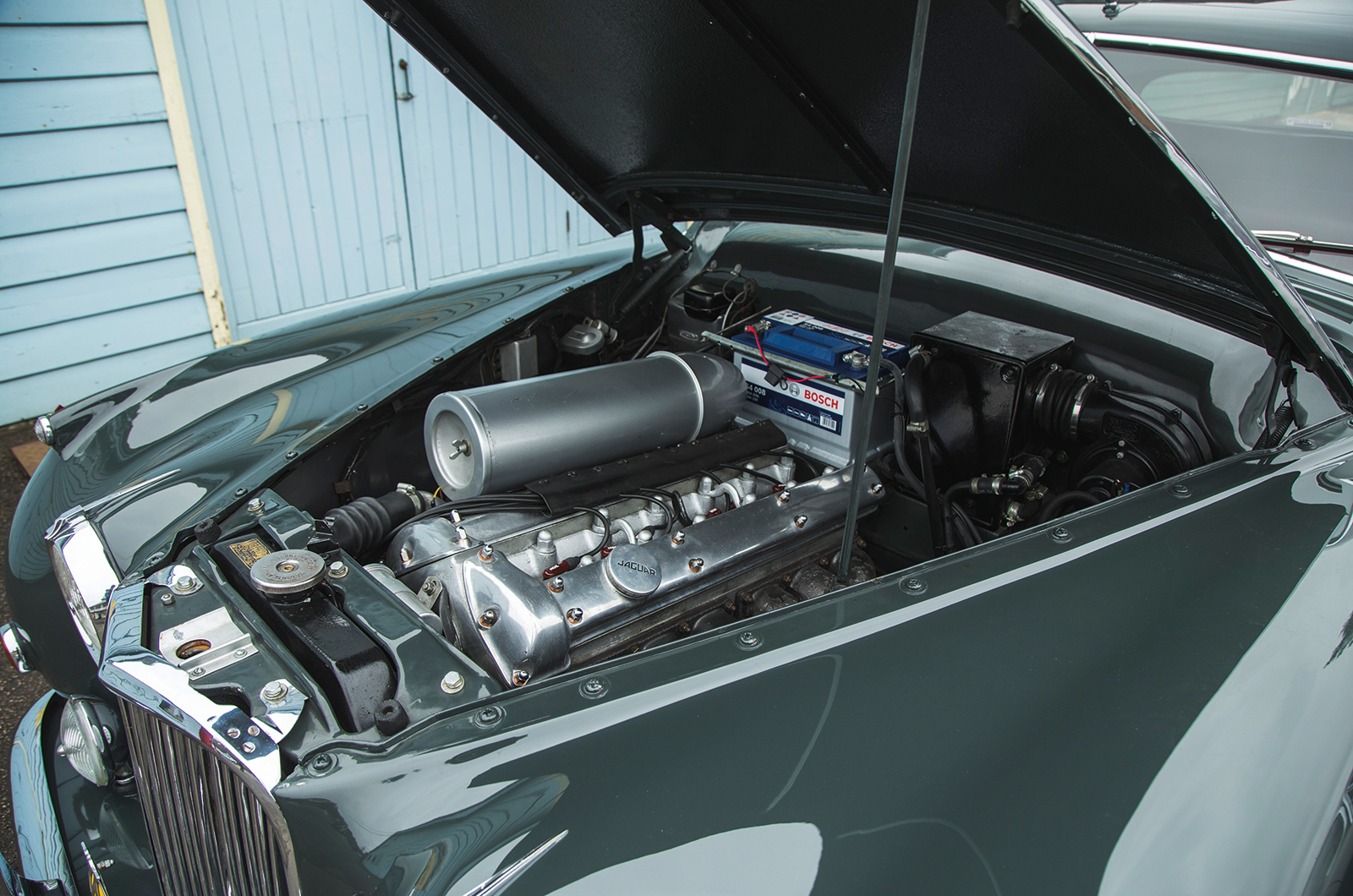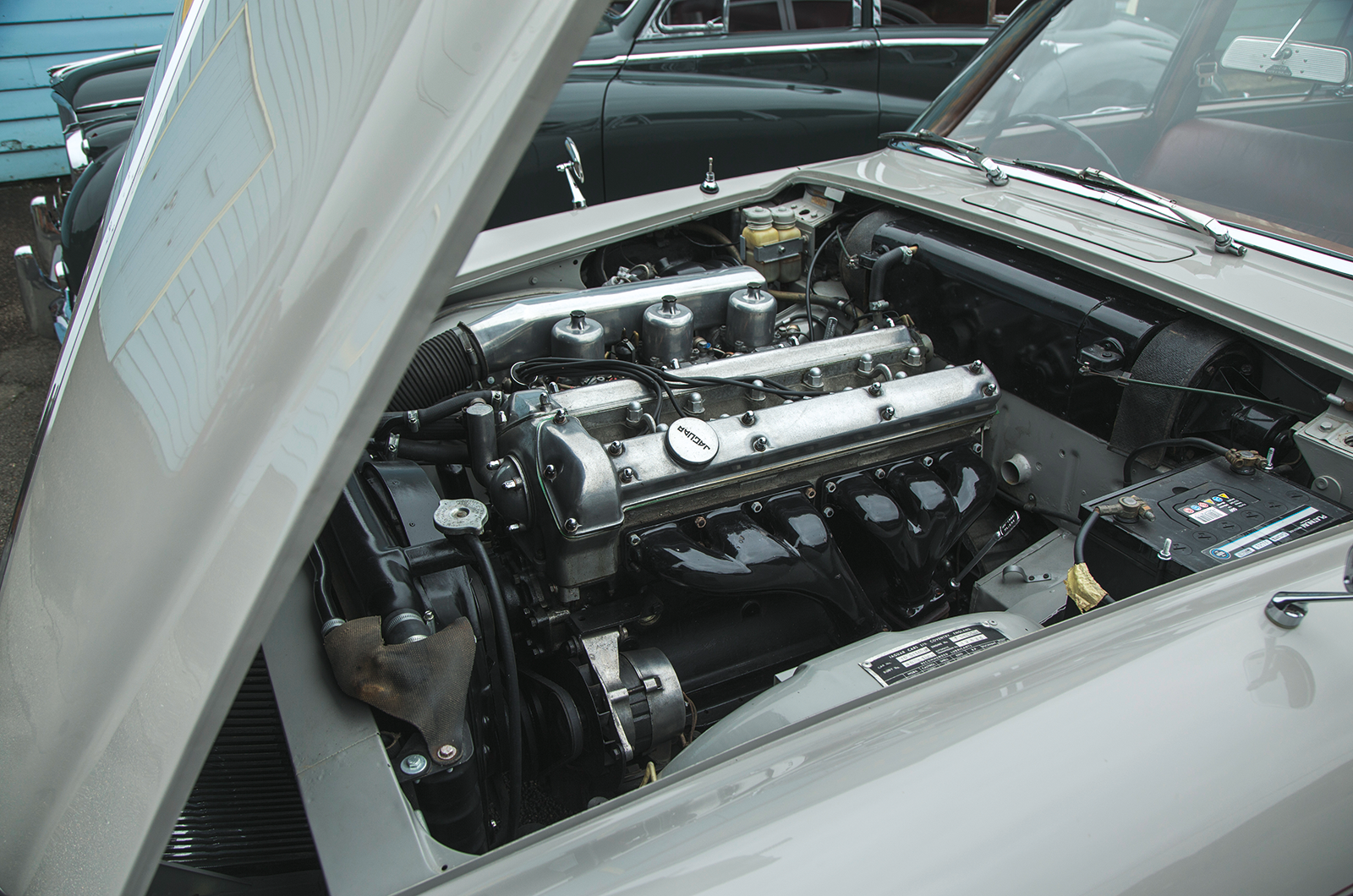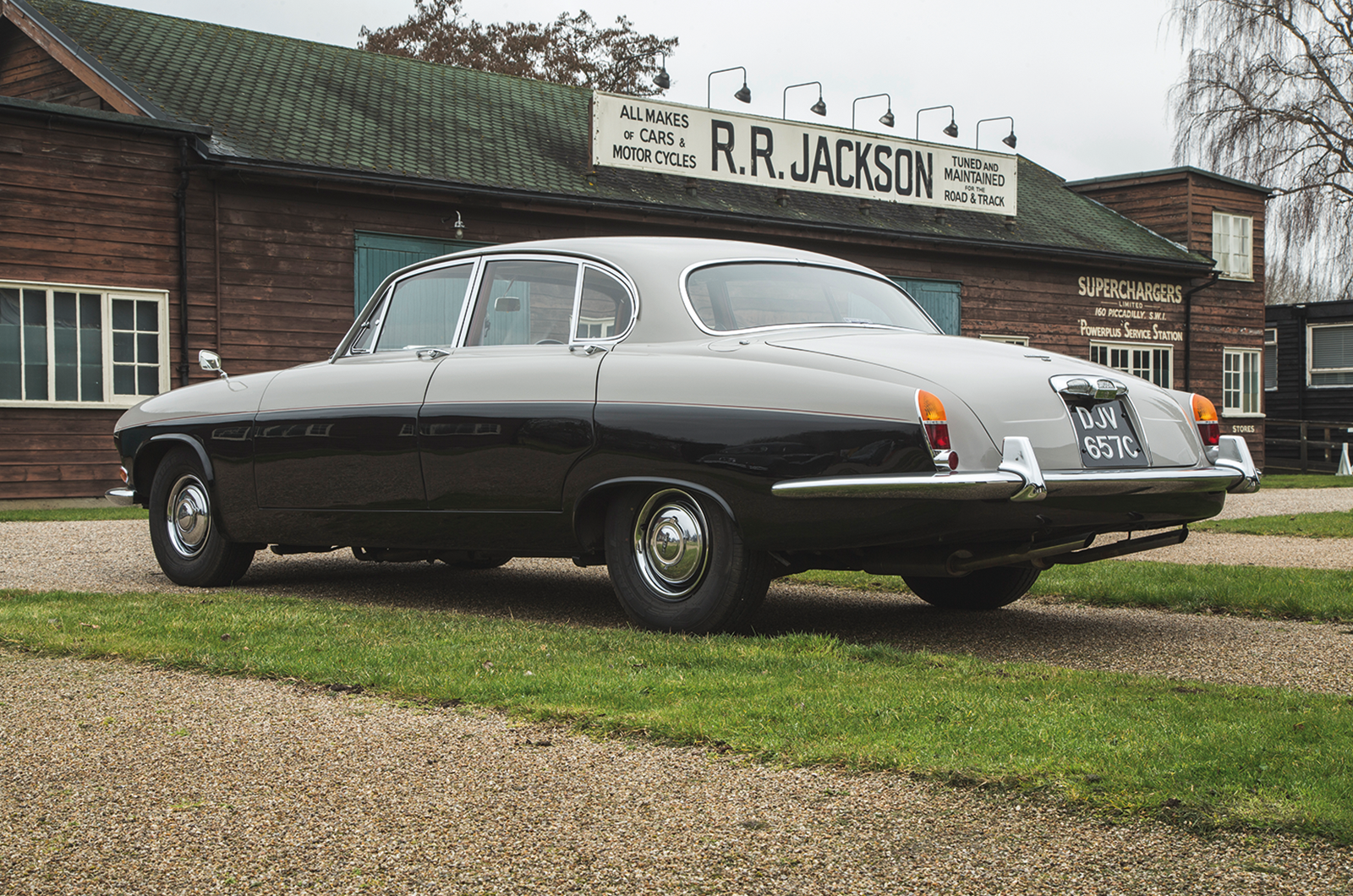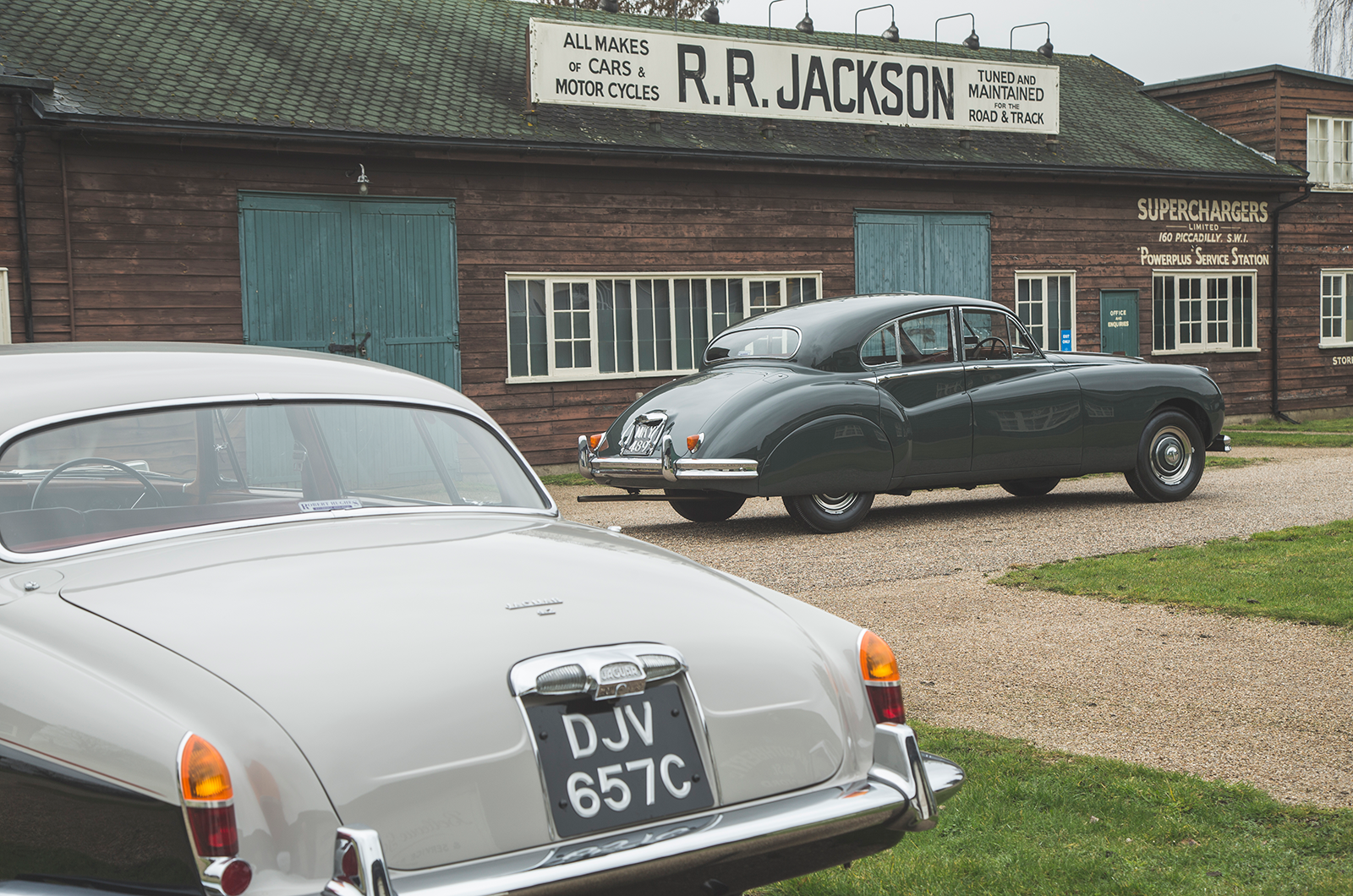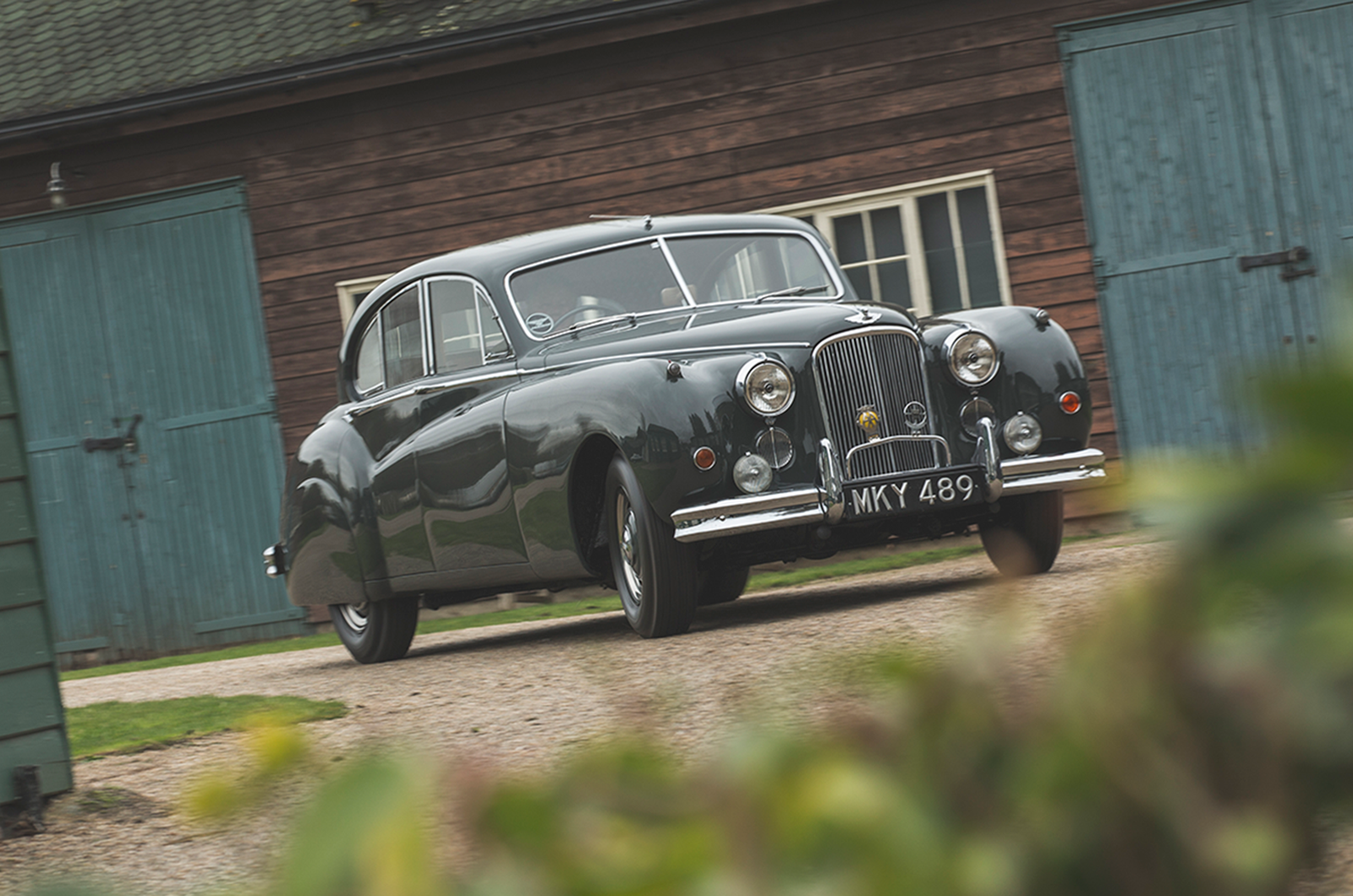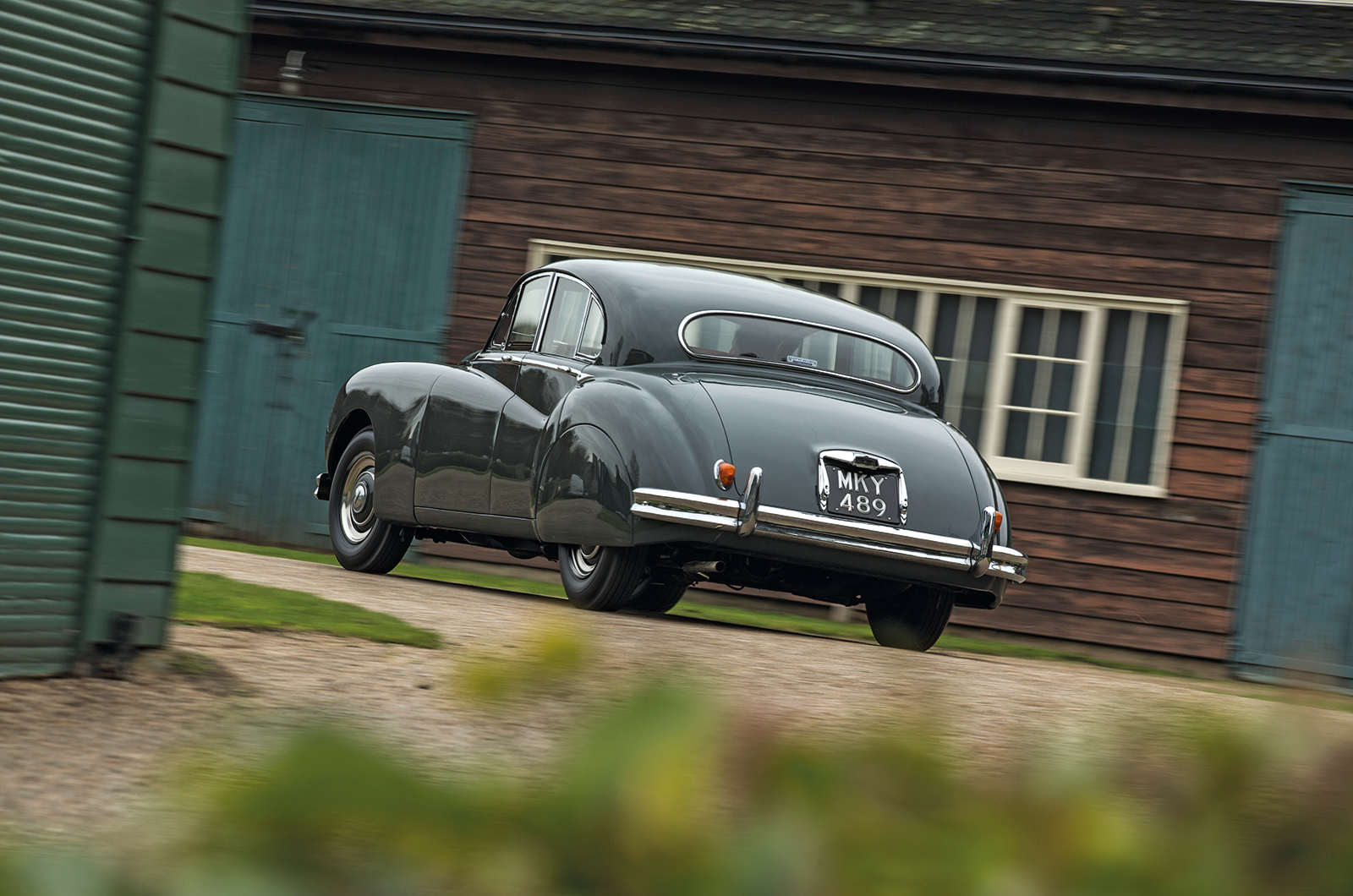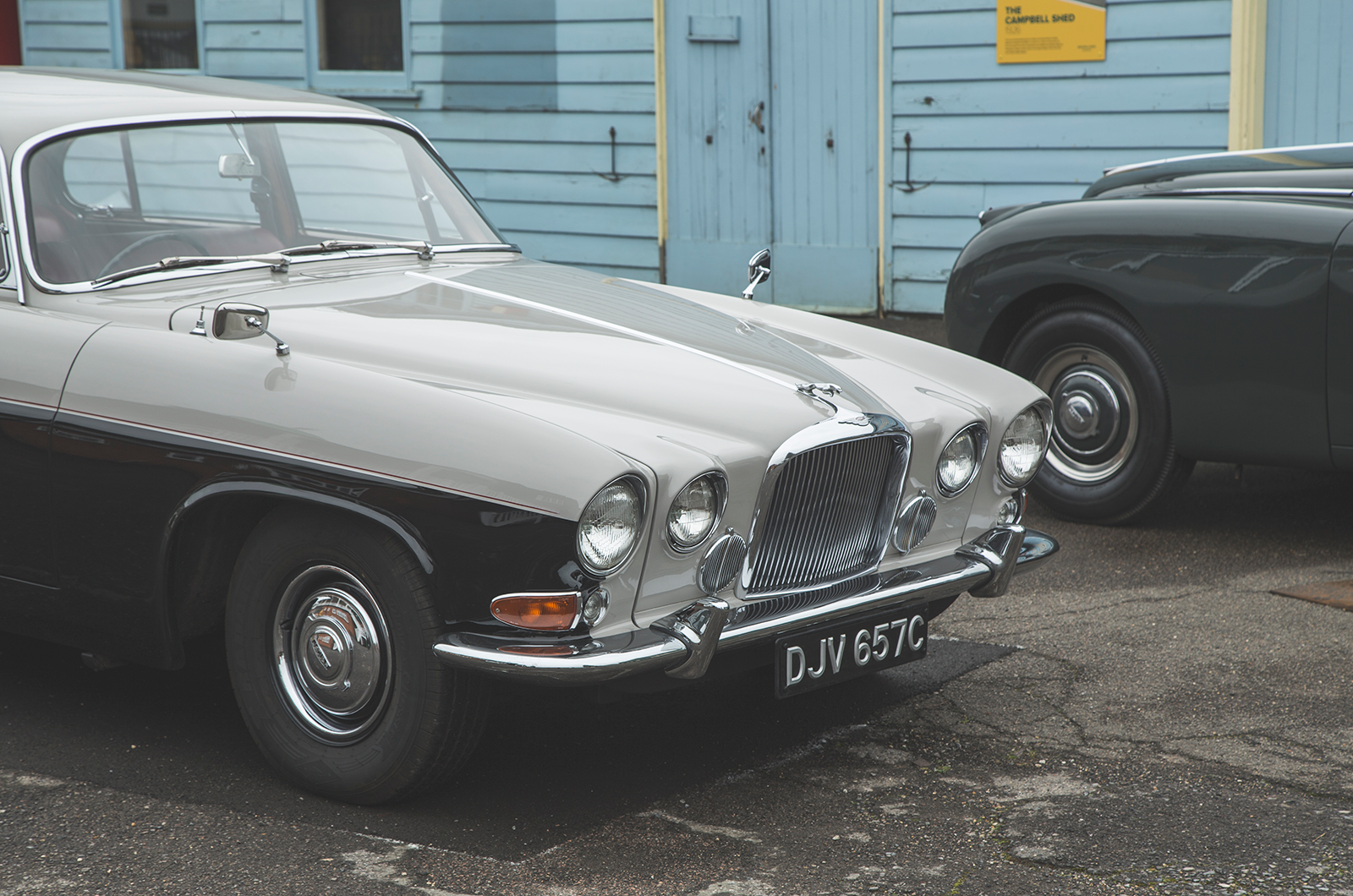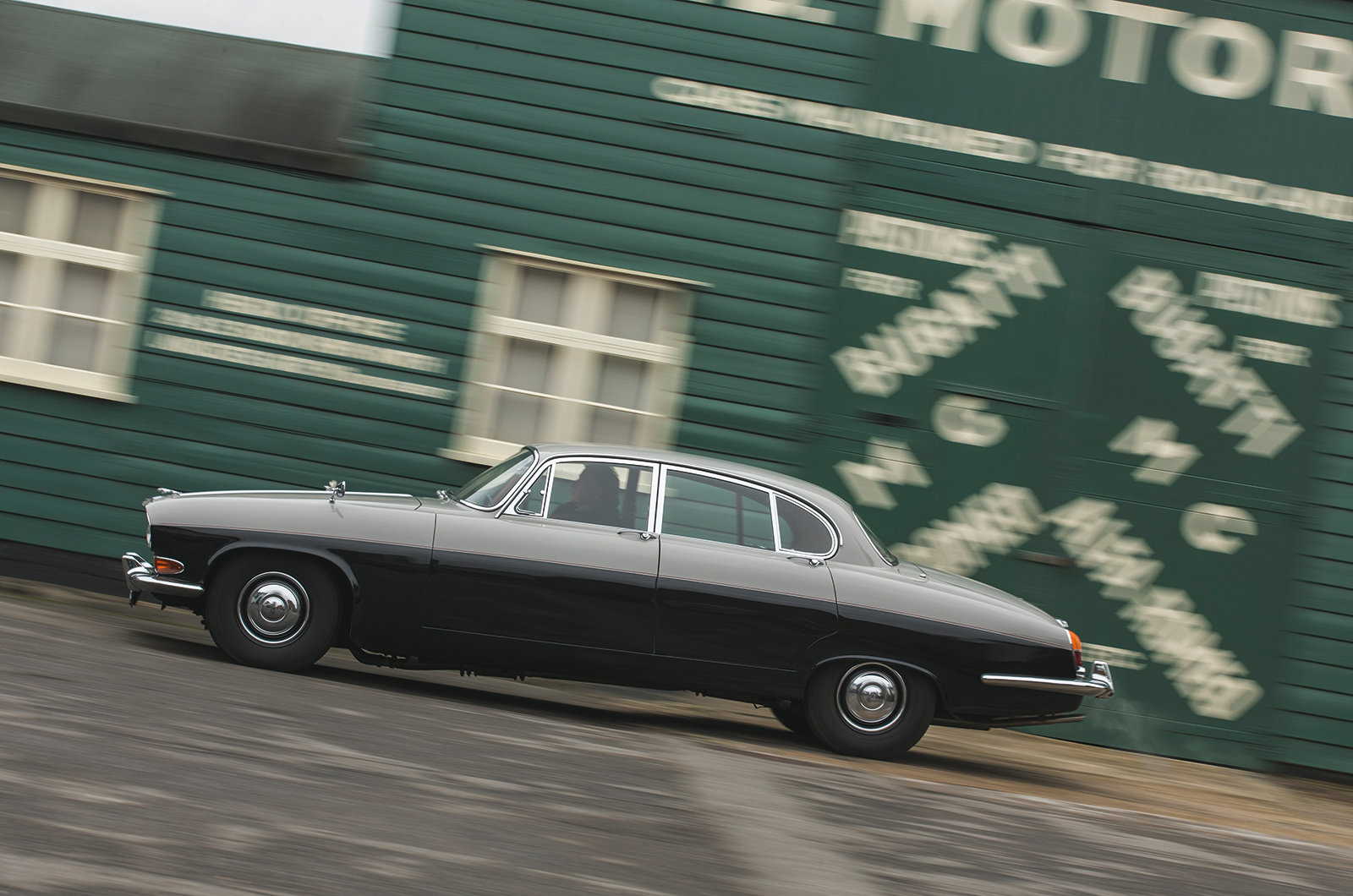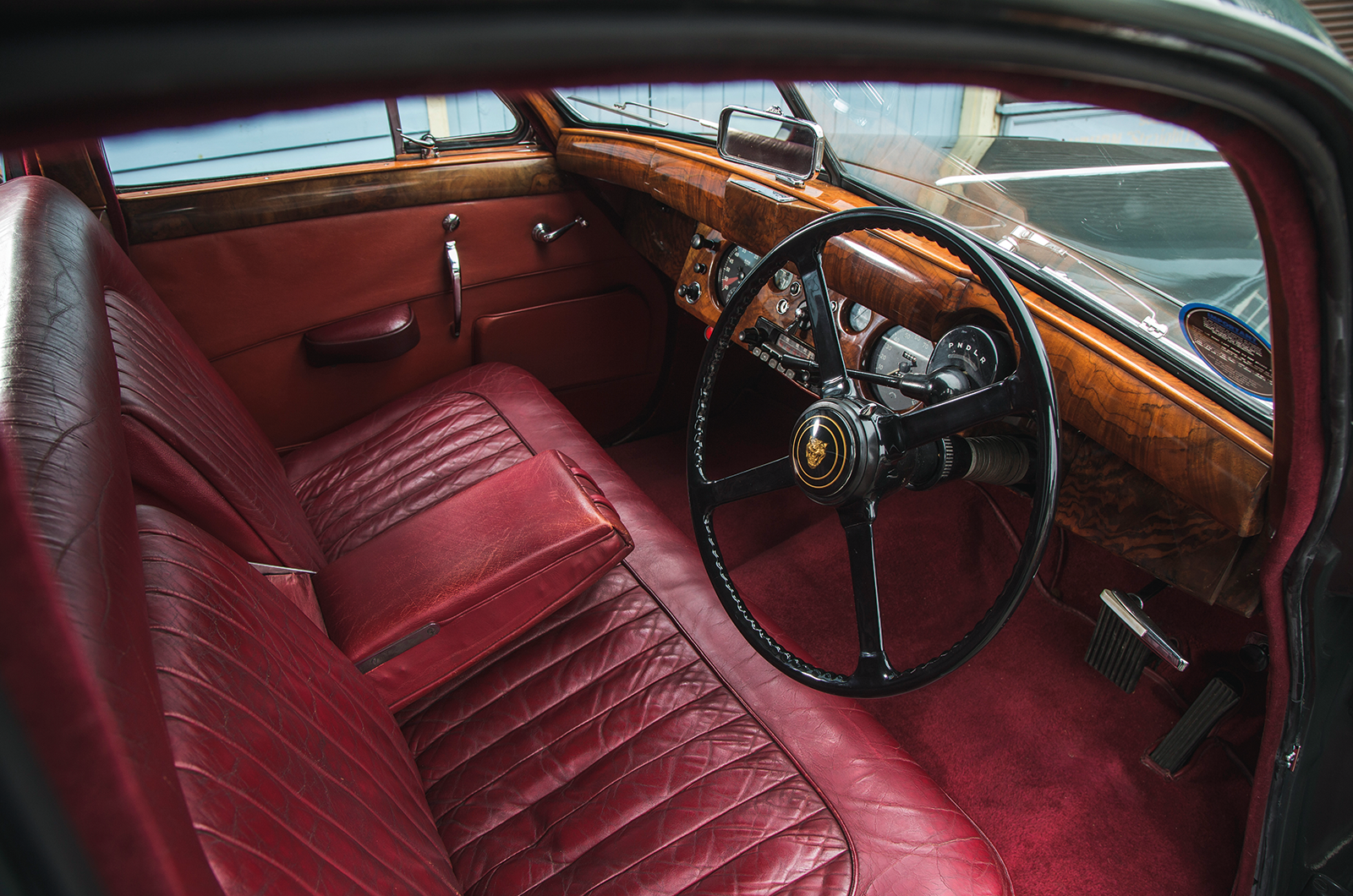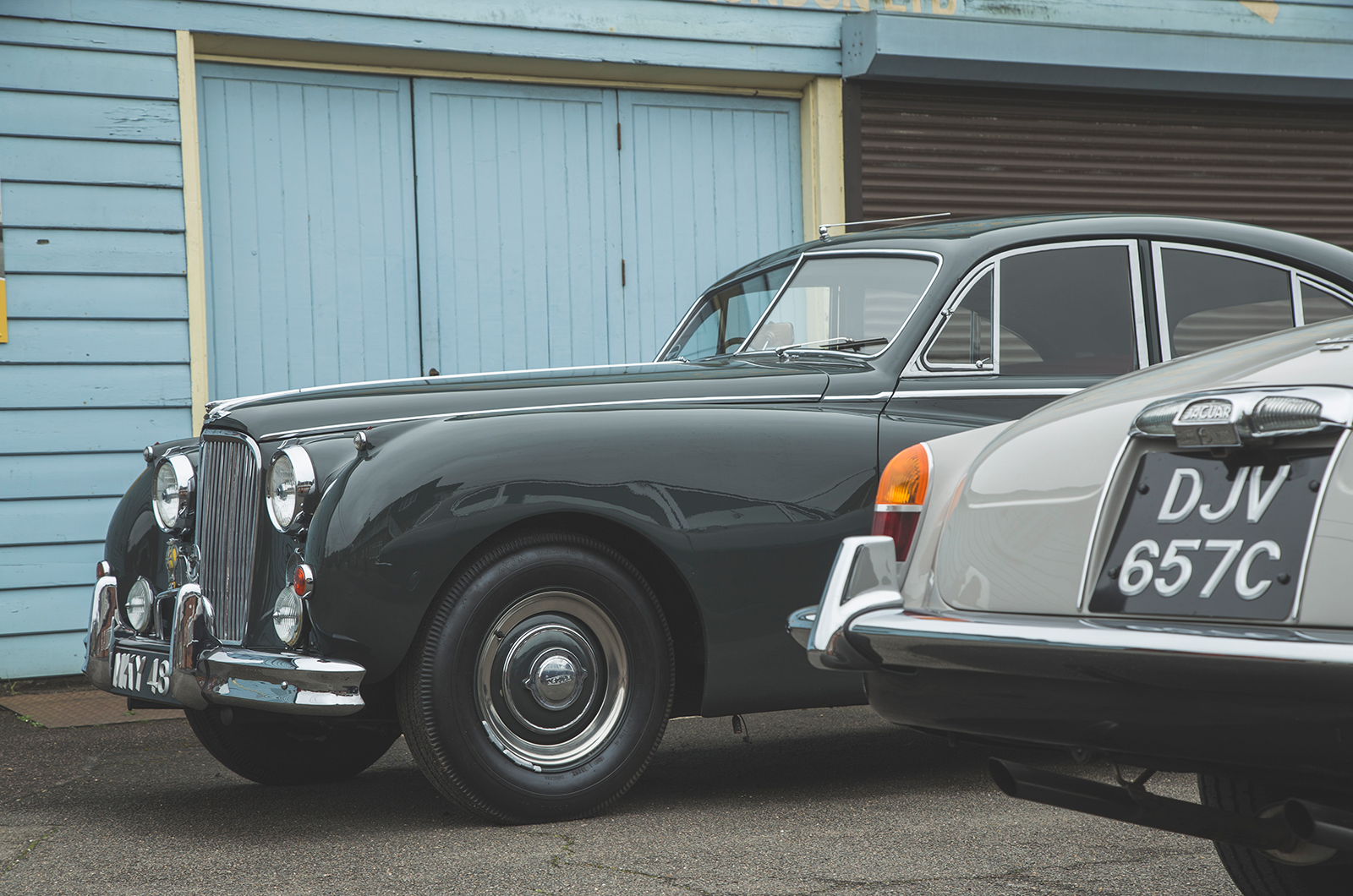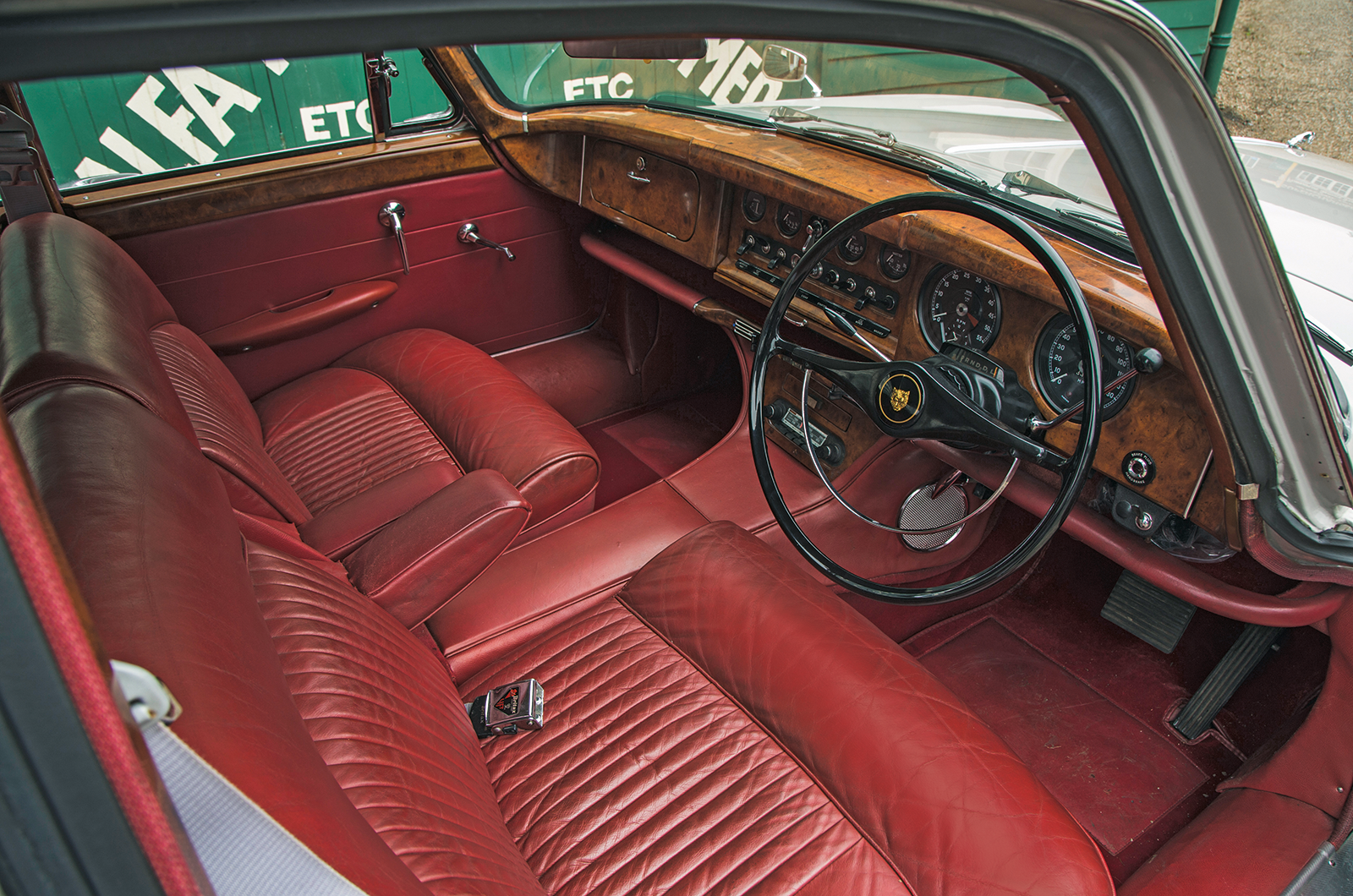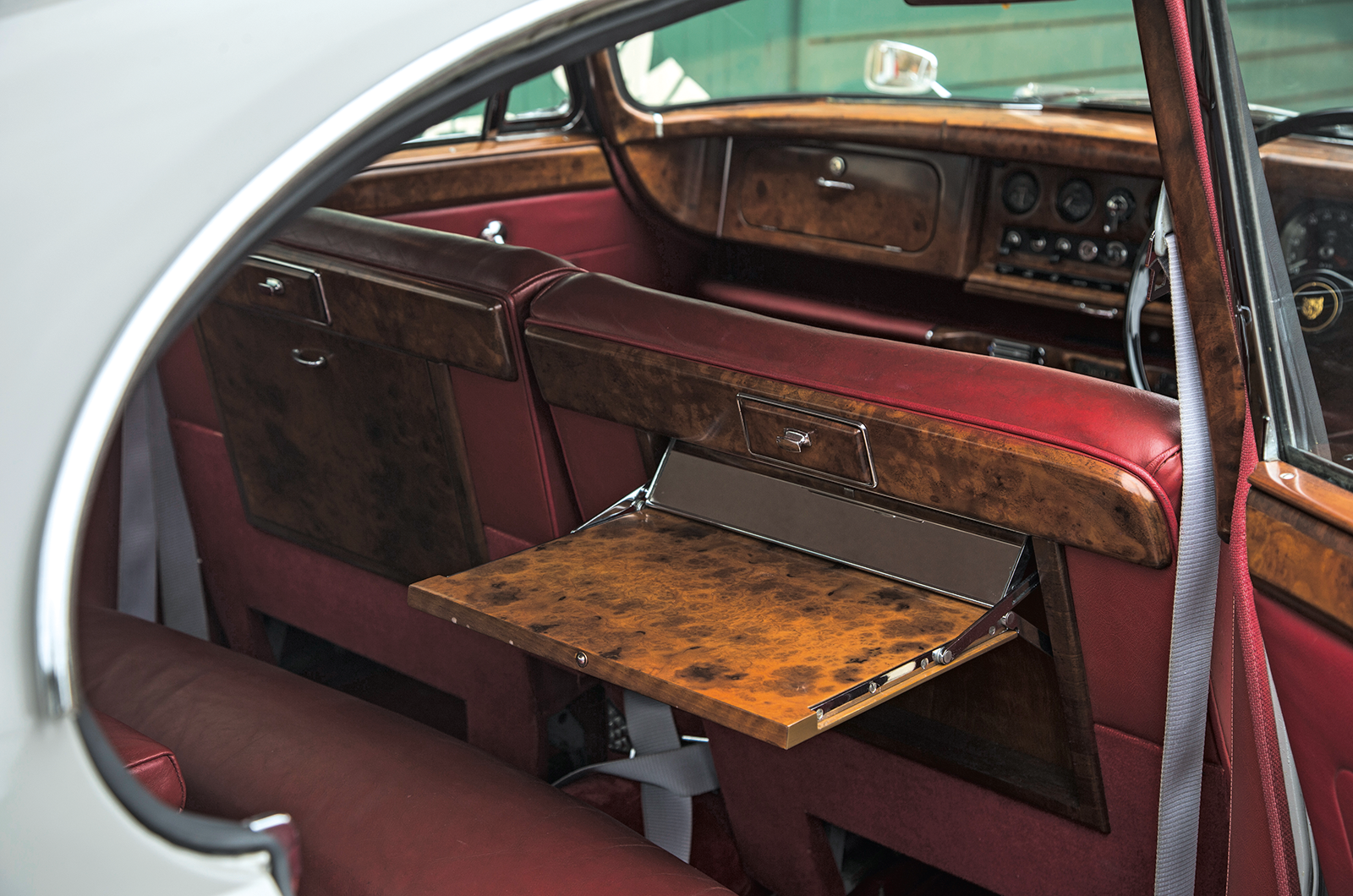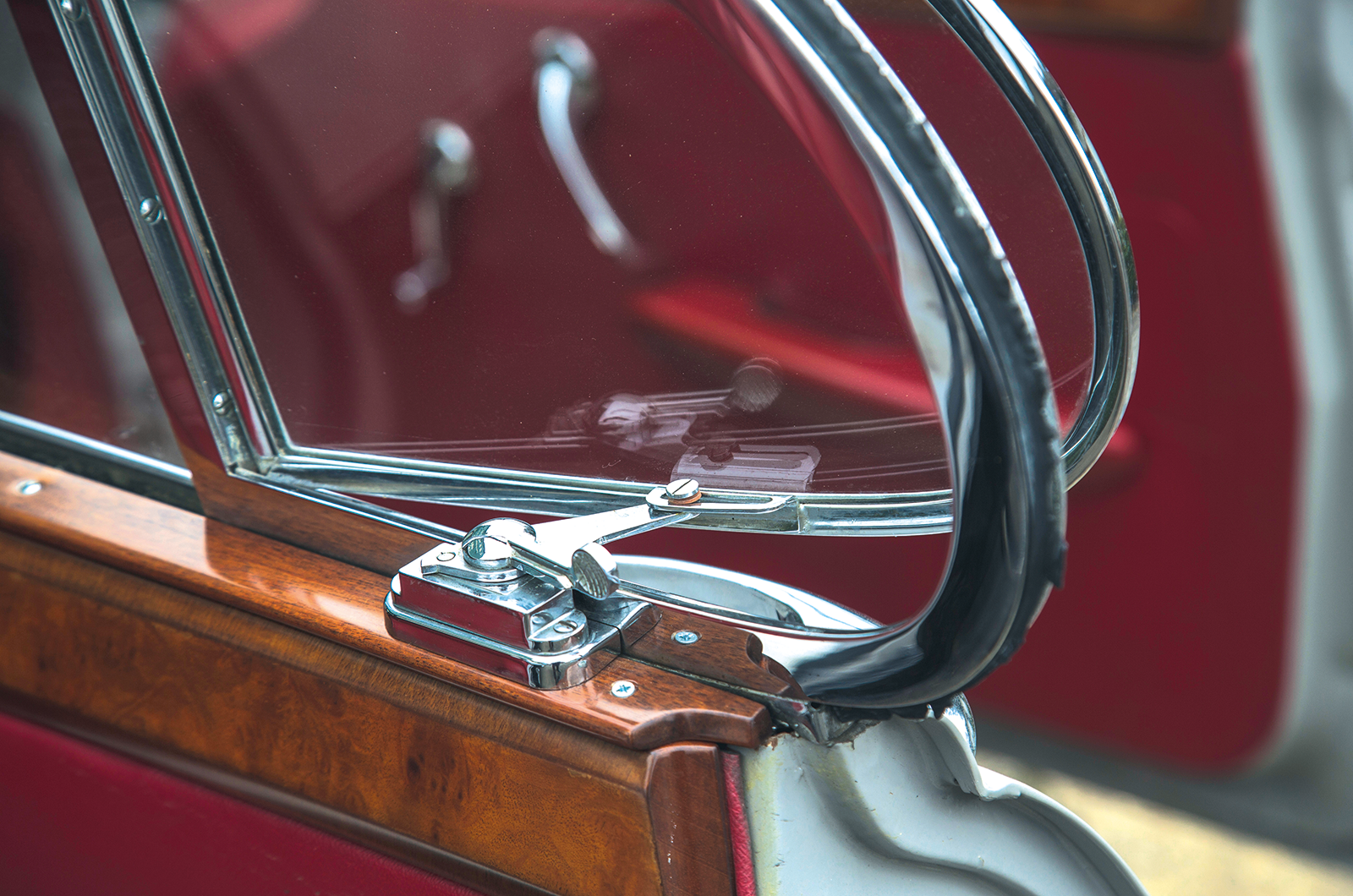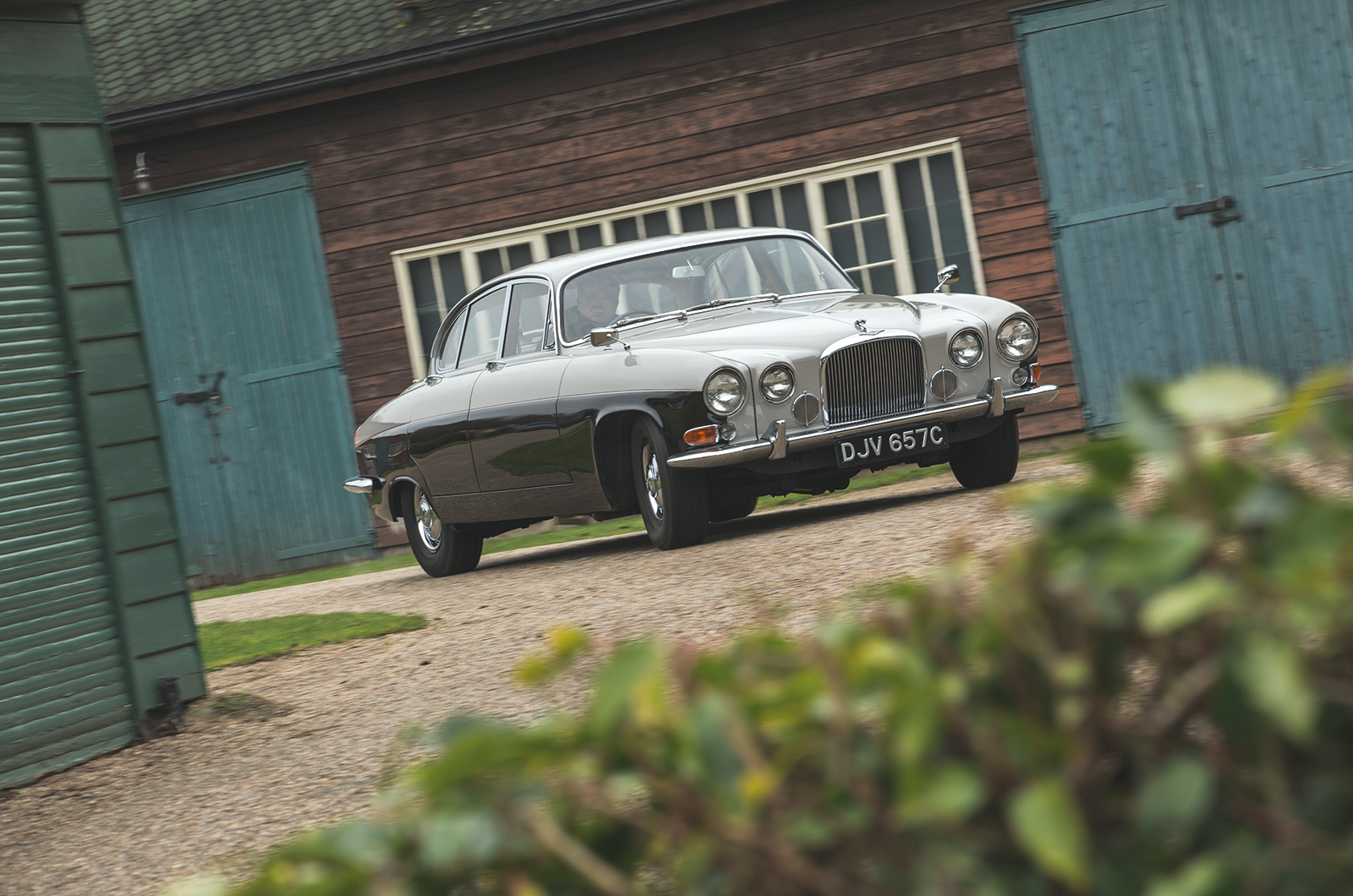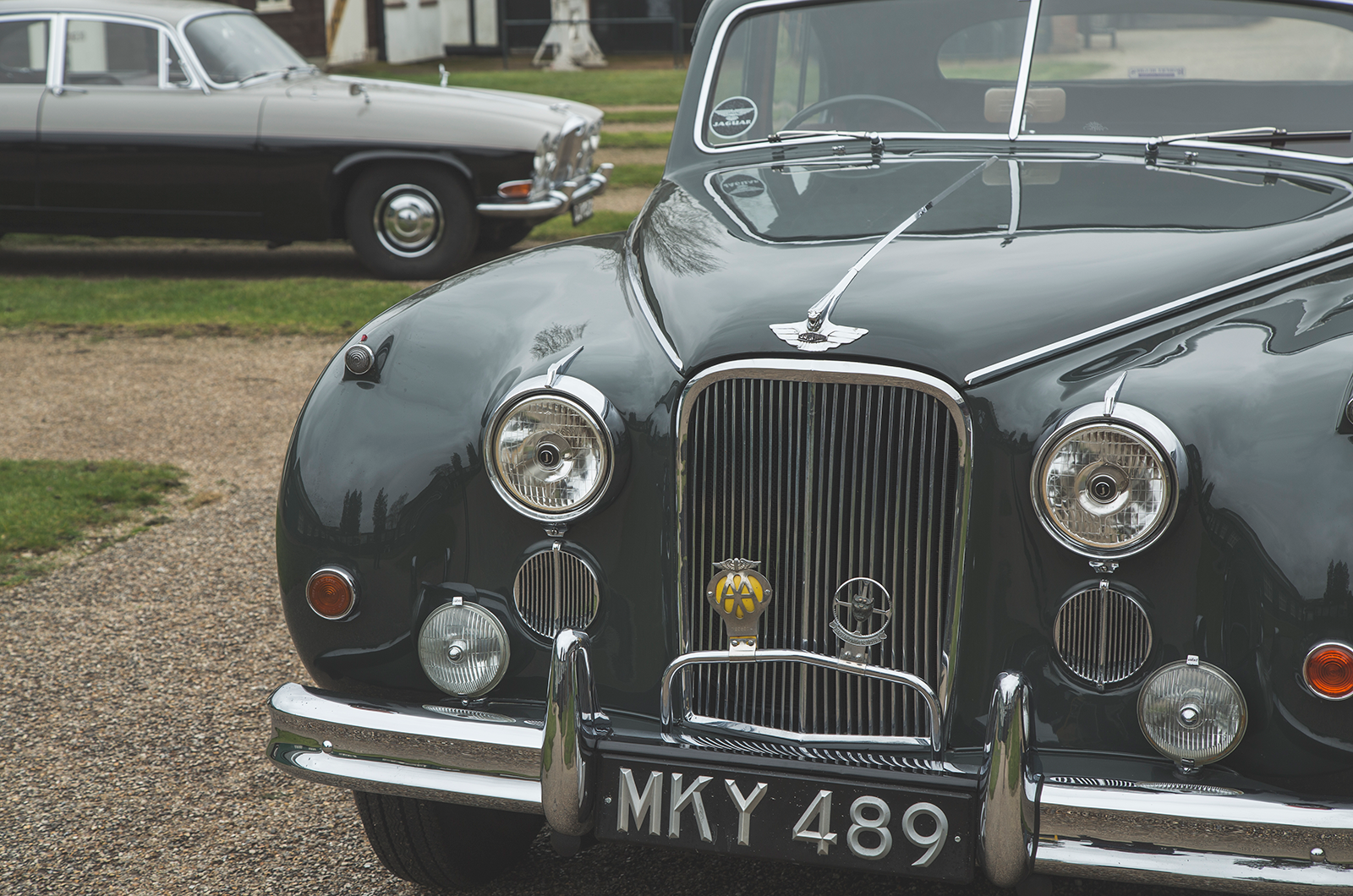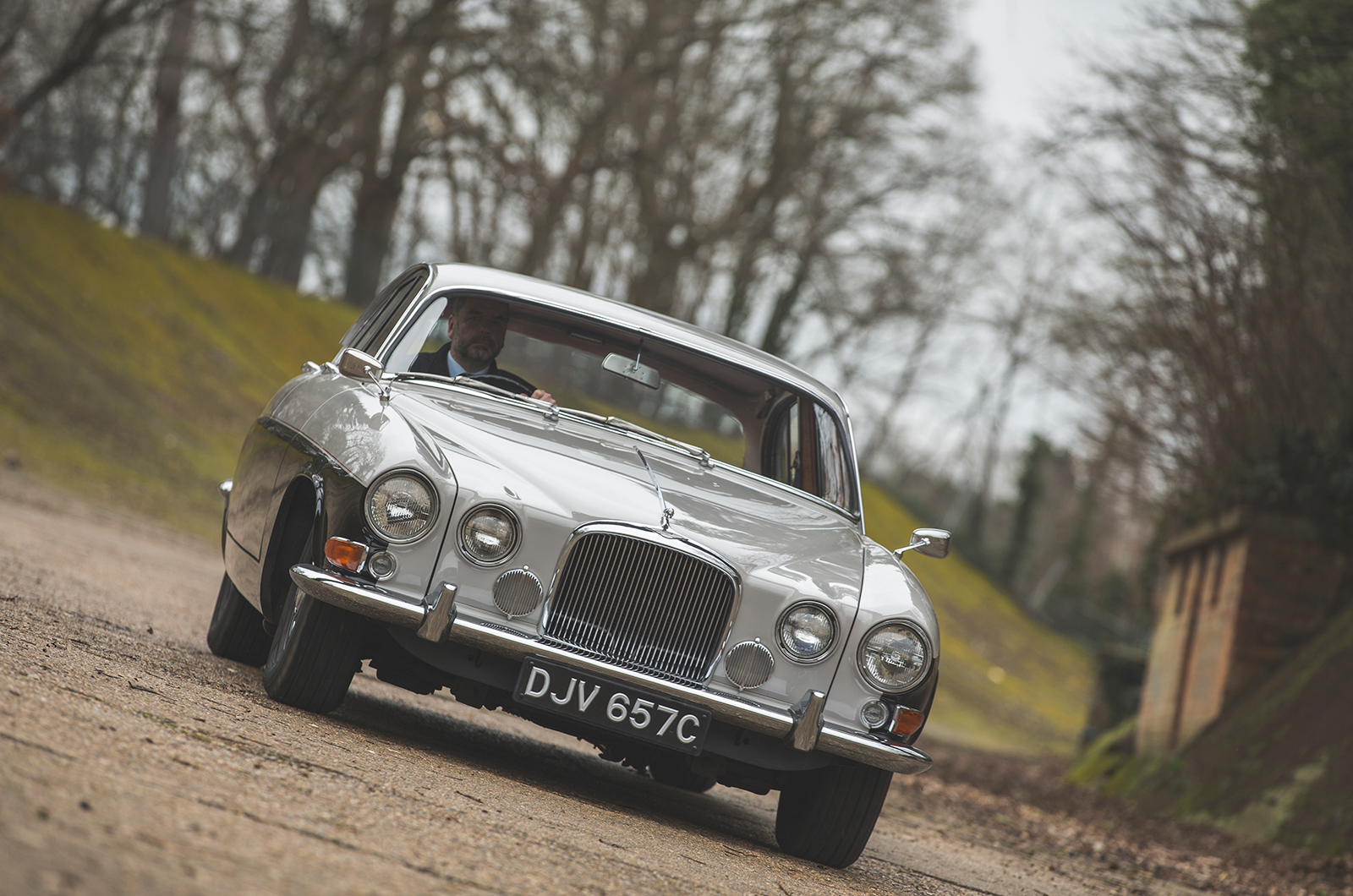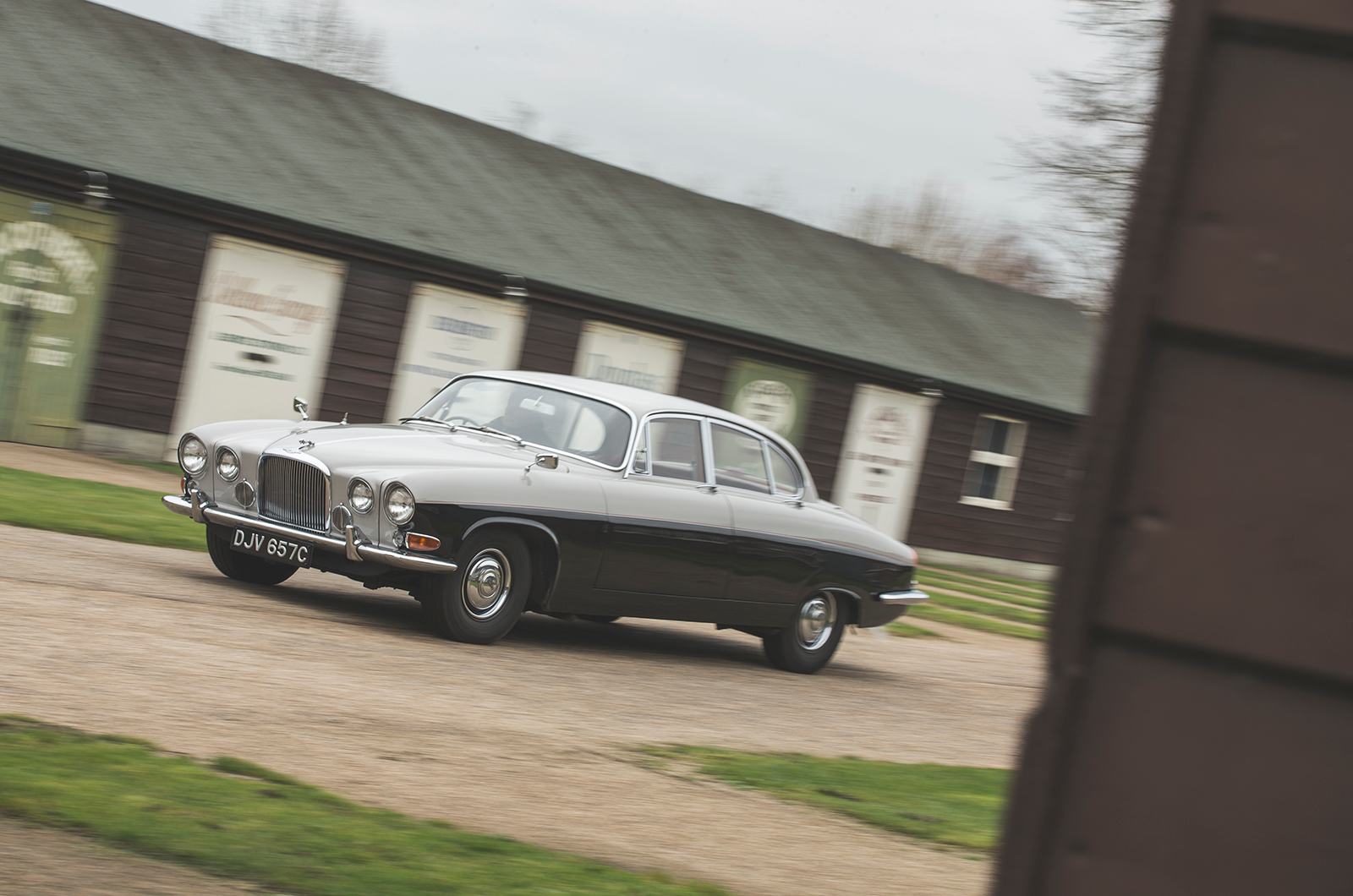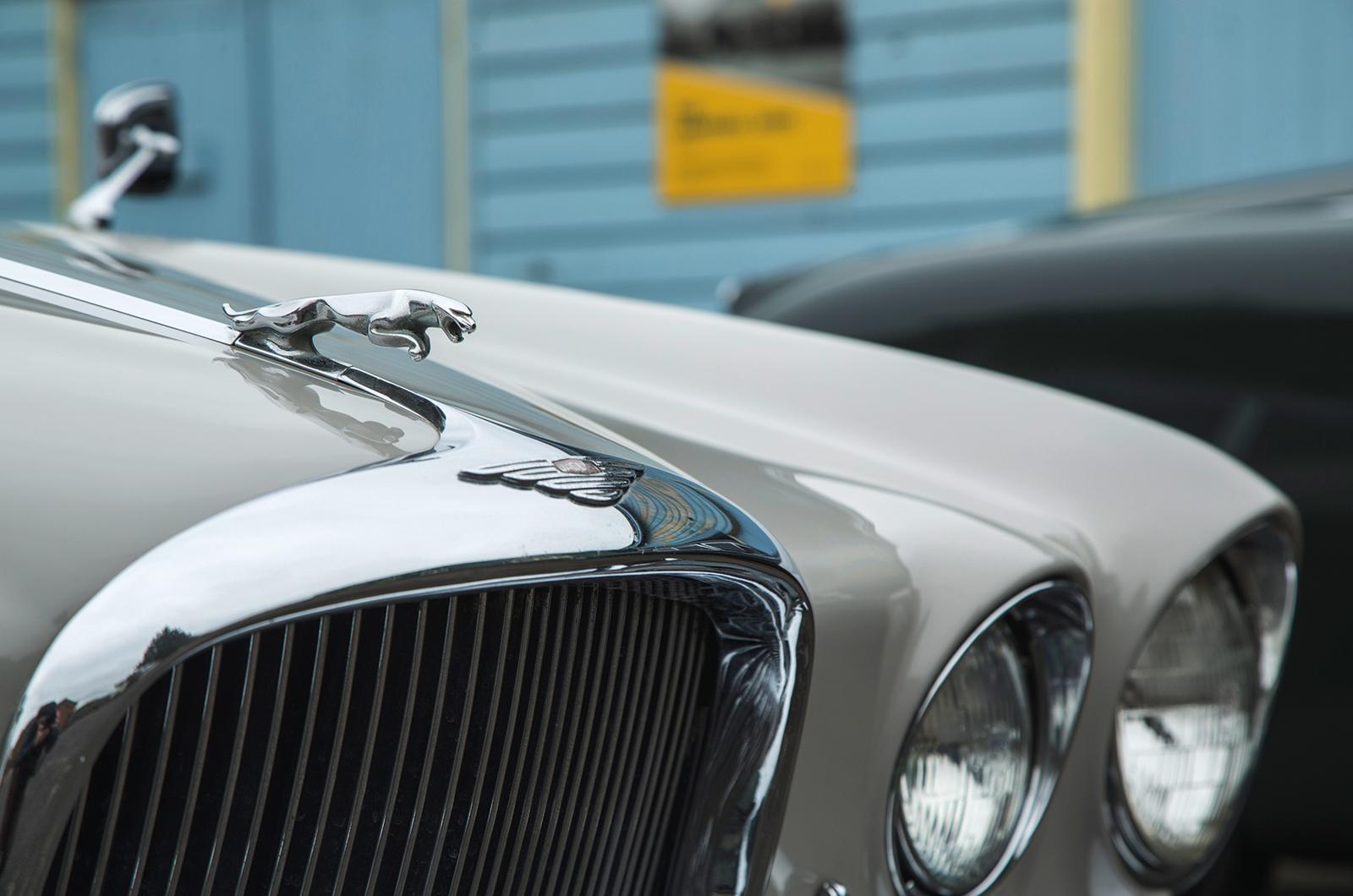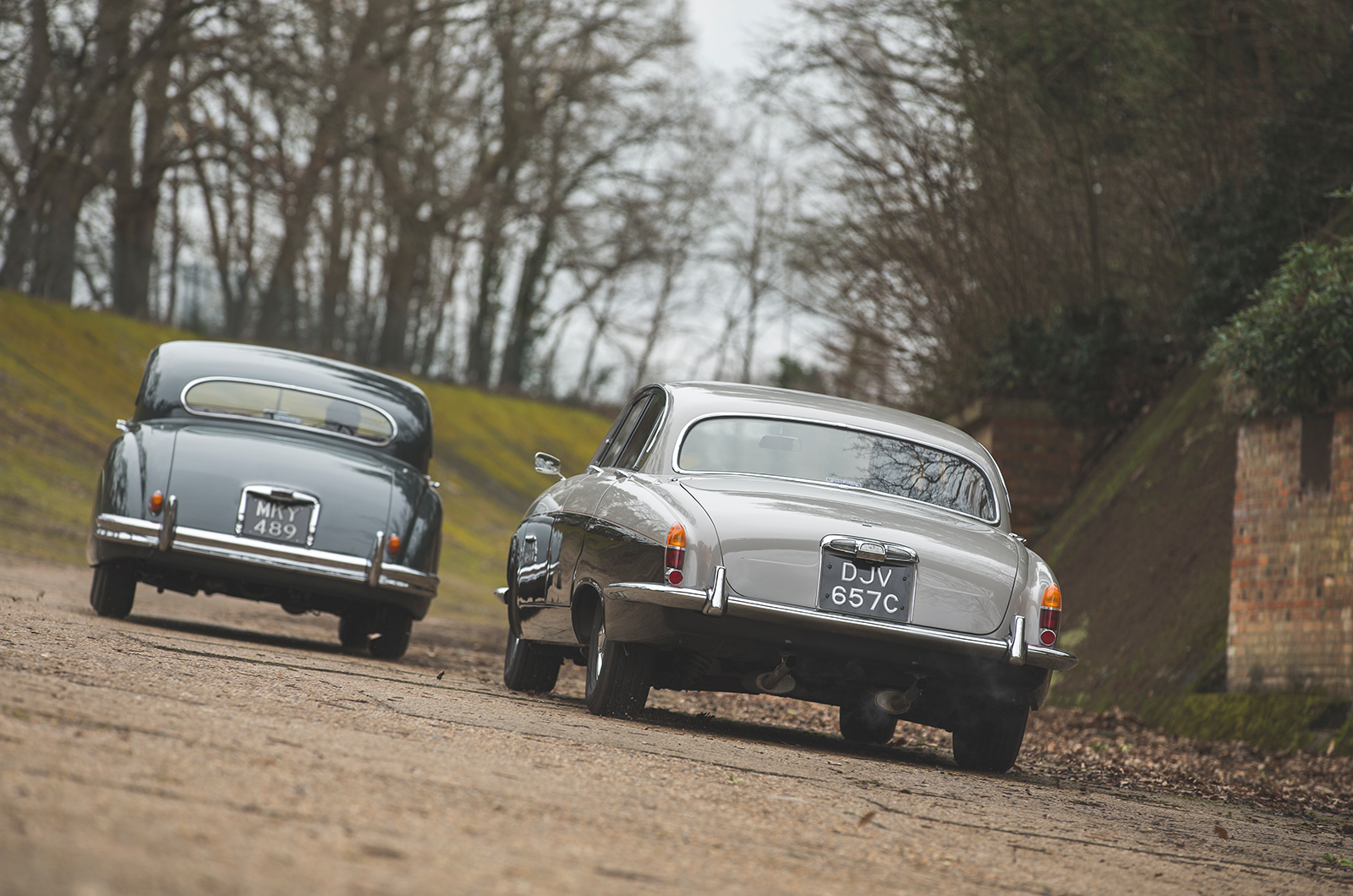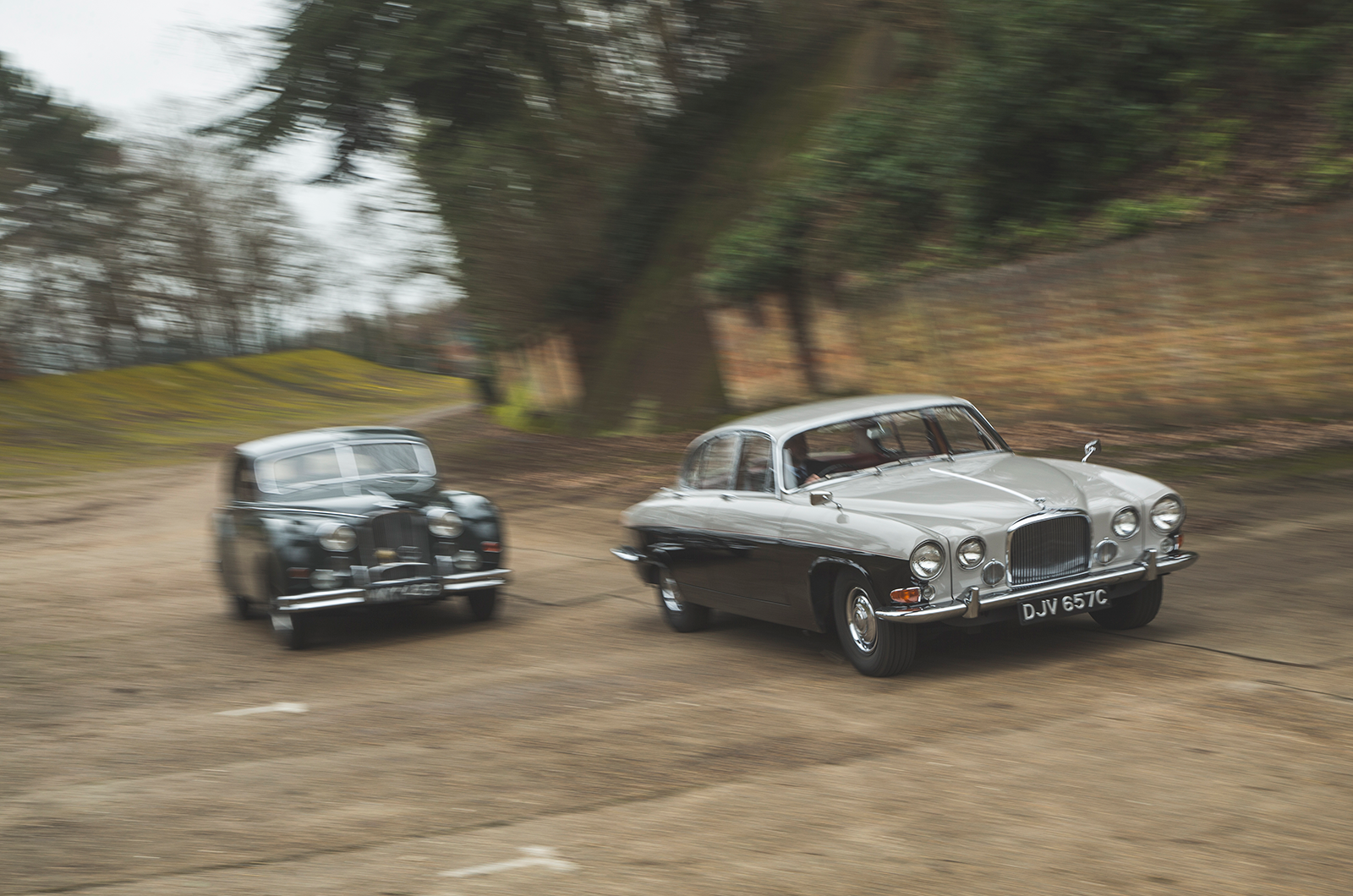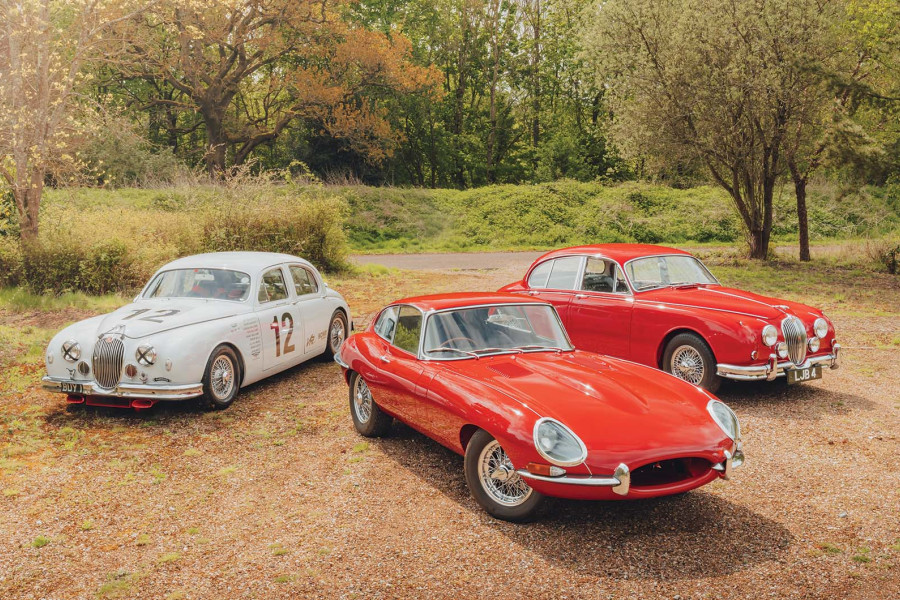Its second owner bought it when it was two years old and had it until the early 1980s, although by then it had already dropped off the DVLA’s records having been taken off the road some time before 1977.
Huge seats fill the MkX’s classy cabin, which has picnic tables for rear-seat occupants
The ‘M’ was Jaguar’s first revision of the big saloon from September 1954, still with the divided windscreen but identifiable by its wing-mounted indicators and foglights placed on the bumpers of a simplified cross-section and which also wrapped around more at the rear.
More significantly, the M’s engine, by using ⅜in-lift camshafts, was boosted by 30bhp to 190bhp.
Such was the car’s export success it was only in ‘M’ spec that these saloons started to appear on British roads in significant numbers.
An automatic transmission, in the form of Borg-Warner ’s DG unit, had been available since 1953 and this car has it. Thus equipped, a bench front seat was obligatory.
The MkX’s nose was a radical departure for Jaguar…
Sliding on to it you immediately feel you are sitting quite low in a car with a letterbox-sized back window that makes the rear quarters feel private and cosy but isn’t great for vision.
The front view, beyond the tiny clap-hands wipers, disappears somewhat abruptly without even a ‘leaper’ for context.
Holding the massive, cold four-spoke wheel you feel rather like the hired help, but there is much consolation in the sense of well-being and luxury you get from the supple leather, gleaming veneers, the West of England Cloth headlining and even the way the instruments are lit.
The XK engine fires instantly on the button and works pleasingly in tandem with the automatic gearbox, which has a neat, crisp selector quadrant.
…as you can see when contrasted with that of the MkVII
It hums through the flat floor in neutral but changes gears smoothly on the move, somehow making the MkVII a less ponderous car to drive than what I recall of piloting manual versions with the gearlever nowhere near where you’d like it.
Acceleration and mpg figures suggest the automatic gave away very little in efficiency to the Moss ’box.
Viewed from the outside, the MkVII whips away from a standing start with a sense of purpose that defies its 1950s origins.
On the inside, low-speed corners or parking manoeuvres mean Scotland Yard-style police-regulation wheel shuffling, yet the steering lightens nicely once up to any sort of speed and centres pleasingly as you straighten up.
Town carriage manners take precedence over any ‘sports saloon’ pretentions in the MkVII. To drive it quickly is fun, but tends to draw unwanted attention to your activities in the form of body roll and tyre squeal that look more alarming than they feel.
The 4.2-litre MkX has 265bhp and a 121mph top speed
This 1965 MkX 4.2 was owned by a lady in Grimsby until 1971, when she sold it to a haulier friend who used the car for holidays until the early ’80s.
“He then stored it in his warehouse,” says Hughes, “simply because there was no point in selling. It had no value. But he took it for an MoT every year, so it’s not been off the road.”
Around 20 or 30 years ago it was sheer size that kept the values of these cars down. “Most people’s garages were not big enough,” explains Hughes.
“The best MkXs are now making £40k and a few have even had £100,000 restorations. Once they get to a certain value the size doesn’t matter; it’s an asset, especially with ‘Goodwood’ cars, which is what both of these are, really.”
Powered-assisted steering in the MkX
The MkX is in all respects a much more suave device than the undoubtedly charming MkVIIM.
It has a far lower centre of gravity and feels more of a piece, which of course it is.
The more logical dashboard, certainly by Jaguar standards, and much better all-round vision put you at ease at once, while the power steering and strong, light brakes give the car a 1970s feel as it gathers pace seamlessly.
The game and lively MkVII easily drifts along with modern traffic, but in the MkX you have the urge in hand to go past much of it.
You could doubtless cruise in the 4.2 at the older car’s 100mph maximum. And even at that rate of knots your rear passengers, luxuriating in the massive legroom, could write legible notes on the picnic tables, so smoothly resilient is the ride.
The famous badge
Regardless of the speed, the MkX is a lot less ‘work’ to drive than its predecessor.
The power steering is light but not absurdly so – it isolates you from the understeer but tends to blur the edges of any ‘feel’ in the way the steering comes back to centre.
Yet it responds precisely to inputs and allows you to command the MkX confidently in all situations, riding a suspension system that generates levels of grip that not only eclipse the cart-sprung MkVII, but also puts the ride of many modern cars to shame.
Yet the MkX, which was a grave disappointment to boss Sir William Lyons, was perhaps the first Jaguar that didn’t sell itself, and the first not to win universal praise from both the press and general public.
Logically its size, comfort and its power-assists should have endeared the MkX to US buyers, but they never took it to their hearts in the numbers Lyons had hoped for.
The fact that the model got off to a bad start with a spate of radiator failures did not help its cause, particularly on the American side of the Atlantic.
Both these Jaguars still cut a dash today
So happy 60th birthday, MkX Jag. Like the MkVII and its successors, you were certainly one of the best saloon cars in the world in your prime.
But you faced tougher and more numerous competition than the MkVII, perhaps most significantly from within your own ranks in the form of the more handily sized – but also fully independently suspended – S-type.
There was a lingering suspicion that you looked like too much car for the money to be any good, in a market where buyers did not necessarily see your bargain price sticker as a positive thing.
Instead, they possibly saw that as a reason to suspect that you were merely a bloated, empty status symbol.
But that much is history. All I know for sure is that the MkX (and the later renamed 420G) will always be my favourite Jaguar saloons. There’s nothing I like better than a bloated, empty status symbol.
Images: Luc Lacey
Thanks to Robert Hughes; Brooklands Museum
Factfiles
Jaguar MkVIIM
- Sold/number built 1954-’56/9261
- Construction steel box-section chassis, steel body
- Engine iron-block, alloy-head, dohc 3442cc straight-six, twin SU H6 carburettors
- Max power 190bhp @ 5500rpm
- Max torque 202Ib ft @ 3000rpm
- Transmission four-speed manual, optional overdrive, or three-speed automatic, RWD
- Suspension: front independent, by double wishbones, torsion bars, anti-roll bar rear live axle, semi-elliptic leaf springs
- Steering recirculating ball
- Brakes drums
- Length 16ft 4½in (4991mm)
- Width 6ft 1in (1854mm)
- Height 5ft 3in (1600mm)
- Wheelbase 10ft (3048mm)
- Weight 3866Ib (1754kg)
- 0-60mph 14.3 secs
- Top speed 100mph
- Mpg 18.5
- Price new £1616
- Price now £15-40,000*
Jaguar MkX 4.2
- Sold/number built 1964-’66/5680
- Construction steel monocoque
- Engine iron-block, alloy-head, dohc 4235cc straight-six, triple SU carbs
- Max power 265bhp @ 5500rpm
- Max torque 283lb ft @ 4000rpm
- Transmission four-speed manual, optional overdrive, or three-speed Borg-Warner Model 8 automatic, RWD
- Suspension independent, at front by double wishbones, coil springs, telescopic dampers, anti-roll bar rear driveshafts as upper links, lower wishbones, trailing arms, twin coil spring/damper units
- Steering power-assisted Marles variable-ratio worm and roller
- Brakes Dunlop discs
- Length 16ft 10in (5130mm)
- Width 6ft 4in (1930mm)
- Height 4ft 6¾in (1390mm)
- Wheelbase 10ft (3048mm)
- Weight 3990Ib (1810kg)
- 0-60mph 10 secs
- Top speed 121mph
- Mpg 18-23
- Price new £2156
- Price now £10-40,000*
*Prices correct at date of original publication
READ MORE
Diamonds are for ever: the Jaguar E-type at 60
How brilliant Bertone reimagined the Jaguar XK150
Shrouded in Turin: Frua’s unique Jaguar S-type
Glamour models: Mercedes-Benz 280SE 3.5 Coupé vs Rolls-Royce Silver Shadow MPW
Martin Buckley
Senior Contributor, Classic & Sports Car

